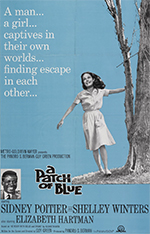
Synergy & Intersectionality
"What are you doing in the dark?"
A Patch of Blue (1965)
Points
for Reflection
A Rhetoric of Film, chp. 4
- Harrington lists the many benefits to the introduction of sound in film. Do you agree that all of these constitute improvements, and do you think this transition period involved any losses?
- does timbre matter as much in common discourse as it does in music?
- dialogue which does not synchronize with the visual images it accompanies can become a kind of voice-over, but sometimes dialogue is just slightly out of sync—enough to draw attention to itself but not enough to constitute voice-over, per se. Can you think of any examples of the latter?
- do you demand background, non-diegetic musical scores in your films, or appreciate the occasional absence of such emotional manipulation?
- Harrington, writing in the early 70s, implies that modern filmmakers no longer use background music to signal the moral nature of a character. Can you identify any exceptions since Harrington’s era?
- is all non-diegetic sound also ambient sound?
- Harrington boasts the benefits of matching a character’s lip movements to spoken dialogue in post-production. Can you recall examples of films which refuse to rely on such looping and ADR, instead determining to record the actual sound present when the visuals were recorded?

A Patch of Blue (1965)
one poster from original film release
Dr. Paul Marchbanks
pmarchba@calpoly.edu
![]()
